Greg Cosell's NFL draft preview: Exciting O.J. Howard leads a deep tight end class
My sense in watching the tape of Alabama tight end O.J. Howard is he has not even begun to scratch the surface as a receiver. I think he will develop into a big-time NFL tight end.
This is a good tight end class with plenty of enticing prospects, but Howard’s skill set stands out. Teams will have to figure out why his production at Alabama never matched his physical skills, but the skills are obvious when you watch him.
Here are Howard’s strengths and weaknesses, with some more breakdowns of the tight end class after that:
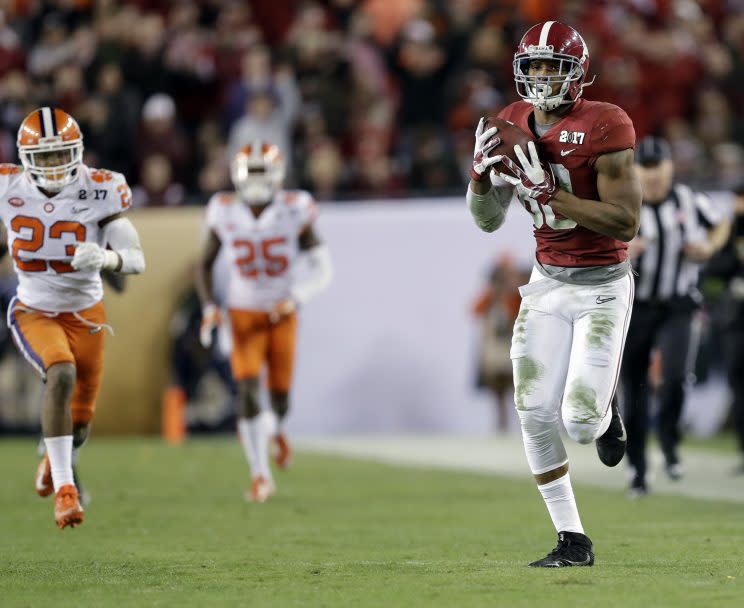
STRENGTHS
What you get with Howard is a very good athlete with long arms (33¾ inches) and big hands. He has the speed as a route runner to run the seams and stretch a defense vertically. He’ll be able to line up anywhere in the formation and win at all three levels: short, intermediate and vertical.
What stands out about Howard is he looks like a big receiver running routes. He has excellent “play speed.” He’s smooth and fluid with good tempo as a route runner.
On a 40-yard catch against USC, Howard was on the line of scrimmage and he got a good release to clear the linebacker, then ran a vertical seam route getting inside and on top of the safety.


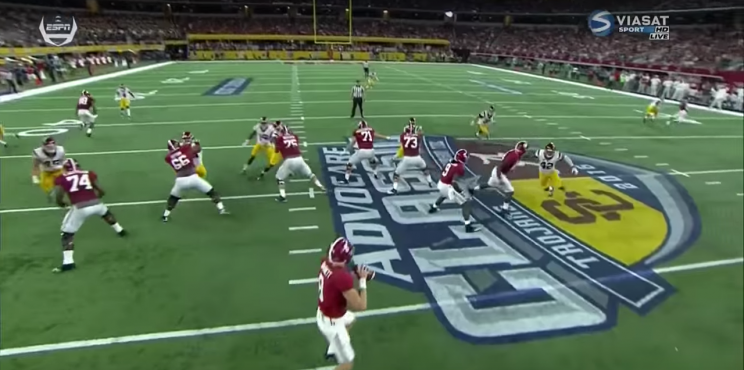
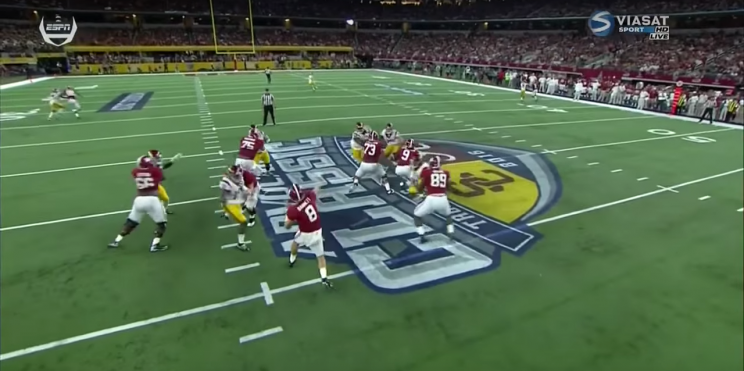

On this 32-yard catch against Florida, Howard (88) got an excellent release off the line of scrimmage to clear the defensive end, then ran an intermediate corner route as part of a three-level stretch concept.



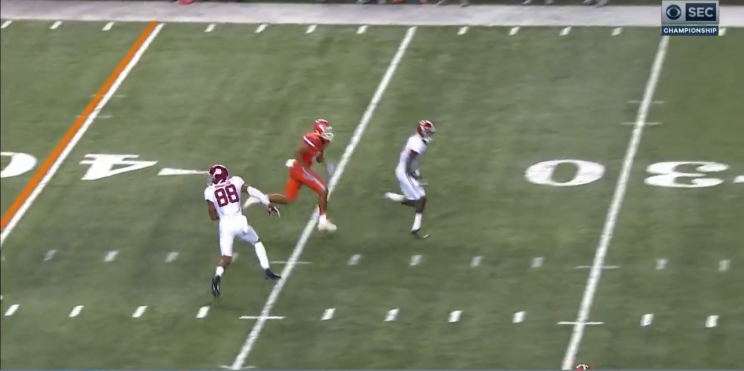

A 68-yard touchdown against Clemson was a schemed play that got Howard open on a go route from the slot. The tunnel screen action influenced the defense. It shows Howard’s long speed.


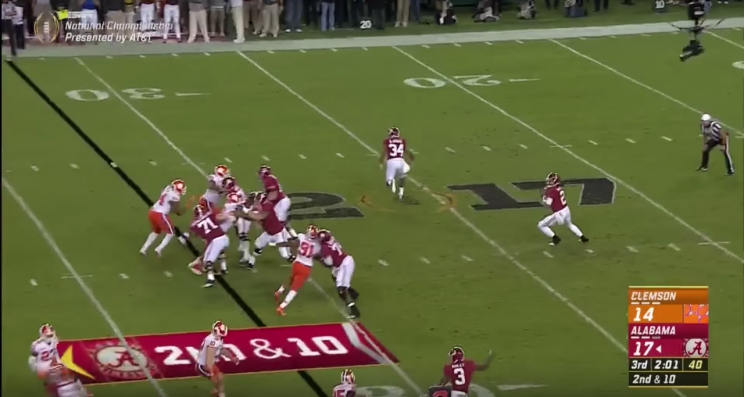


In Howard’s tape, you can see the athleticism and movement to win one-on-one against safeties both tight to the formation or detached from it. He’s comfortable and effective running seam and corner routes. He showed the ability to catch easily with soft hands, and a run-after-catch burst.
What Howard brings that many tight ends don’t is the ability to block. He has extensive experience as a run blocker aligned in different spots in multiple run schemes. He has a finishing mentality as a blocker. Given his ability as a receiver, that’s impressive.
WEAKNESSES
Over the past two seasons at Alabama, Howard had just 1,197 yards and five touchdowns. Why was he not featured more in the Crimson Tide’s passing game? Why were so many of his catches the result of the scheme (like the touchdown against Clemson above)? There may be nothing to that at all, which I think is the case, but teams have to look deeply into those questions.
Howard isn’t complete as a blocker, especially from the line of scrimmage. He has consistent effort but a tendency to fall off blocks too quickly. He must become more physical as a run blocker and not rely on positioning and finesse. Still, he offers more as a blocker than most tight ends in this draft class.
Overall, Howard projects as a fine combination blocker-receiver at tight end. The ability for a tight end to line up out wide, at the “X iso” position, has become an important part of NFL offenses and Howard has the ability to do that. He’ll be a versatile piece for whichever team drafts him.
Here are some thoughts on a few other tight ends in this class:
MIAMI TE DAVID NJOKU
Like Howard, Njoku is a complete and multi-dimensional tight end prospect. He can block and is a good receiver, able to fit in any offense with a multiple skillset. There will be no issues with scheme adaptability because Njoku can fit any scheme. And like Howard, he can also win as a receiver at all three levels of the defense.
I see some similarities between Njoku and Eric Ebron of the Detroit Lions, but Njoku is a much better blocker and more complete player.
Njoku will need to become more nuanced and refined as a route runner, and needs coaching and experience as an in-line blocker. But he is long, athletic, with good hands and outstanding acceleration in the open field. He has the look of a first-round pick who can develop into a complete, dynamic NFL tight end.
MISSISSIPPI TE EVAN ENGRAM
What stood out with Engram was the number of vertical routes he ran: seams, wheels, slot fades and corner routes. He’s quick into his routes and a fluid strider with easy movement as a route runner.
Engram can line up anywhere, including in the backfield. The ability to detach from the formation and win in space is a plus. What concerned me a bit is Engram didn’t always play to his timed speed as a route runner. He didn’t consistently look explosive running vertical routes, and also at times showed inconsistent hands, with drops and not catching the ball easily. Also, he’s not a very good in-line blocker and there’s no real physical element to his game.
Engram fits the profile of an athletic tight end who can create mismatches. Almost every NFL team uses tight ends as attached receivers and Engram can fill that role, like Jordan Reed of the Washington Redskins. There are a lot of athletic tools to work with and if he’s used effectively he has a chance to be a dynamic player.
SOUTH ALABAMA TE GERALD EVERETT
As with most tight ends in this class, the issue with Everett is he has very little experience as an in-line blocker in the run game from the line of scrimmage. That’s a concern that must be evaluated hard, and teams that feature the tight end as critical blockers in the run game may not see Everett as a high-level prospect.
However, Everett is a plus athlete with the athleticism and versatility to align anywhere in the formation and be a weapon as a receiver. Engram might be faster but Everett is a more efficient route runner and better after the catch, and I view Everett as a more complete receiving prospect than Engram.
VIRGINIA TECH TE BUCKY HODGES
Hodges practically played receiver in 2016, with all of his targets coming from the slot or outside the numbers. He has size (6-foot-6, 257 pounds) and athleticism, and could perhaps develop into a Jimmy Graham-type receiver, but his deployment in an NFL offense is a concern. He didn’t align at a conventional line-of-scrimmage tight end position and therefore didn’t in-line block in the run game or have to release into routes through traffic inside.
At this point he’s a flexed and detached receiver, and the question will be is if he can transition to play on the line at tight end, which will be necessary if he’s to be a full-time NFL player.
More NFL draft breakdowns from Greg Cosell:
• Clemson QB Deshaun Watson
• North Carolina QB Mitchell Trubisky
• Notre Dame QB DeShone Kizer
• Texas Tech QB Patrick Mahomes and Cal QB Davis Webb
• LSU RB Leonard Fournette
• Stanford RB Christian McCaffrey
• Oklahoma RB Joe Mixon
• Florida State RB Dalvin Cook
• Clemson WR Mike Williams
• Western Michigan WR Corey Davis
• Texas A&M DE Myles Garrett and the defensive line class
– – – – – – –
NFL analyst and NFL Films senior producer Greg Cosell watches as much NFL game film as anyone. Throughout the season, Cosell will join Shutdown Corner to share his observations on the teams, schemes and personnel from around the league.


